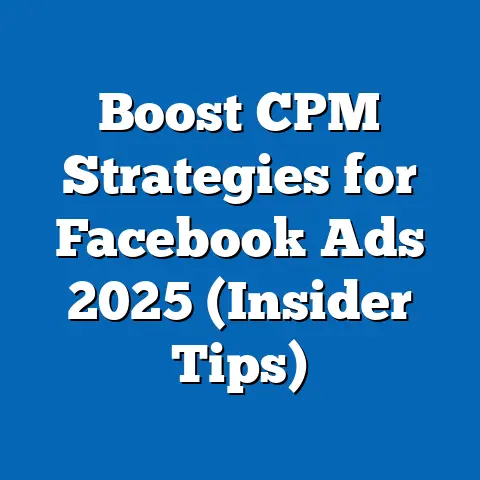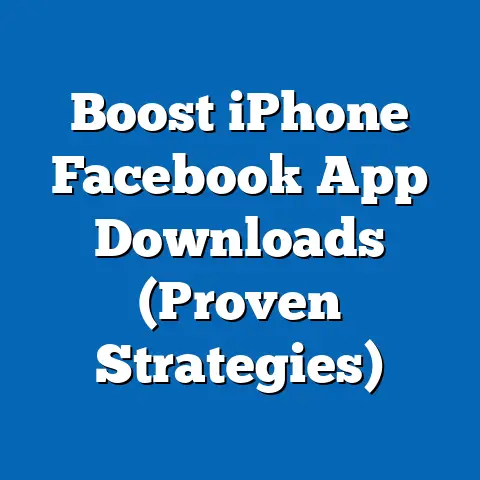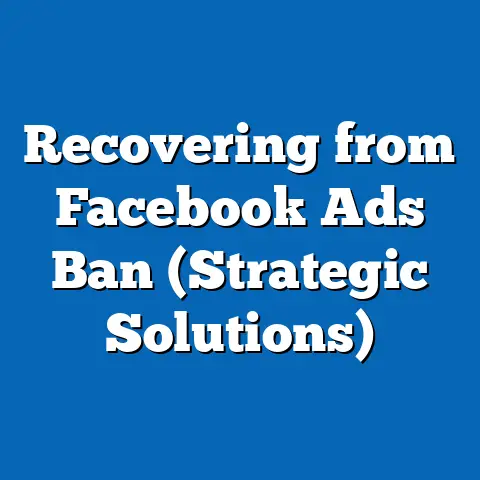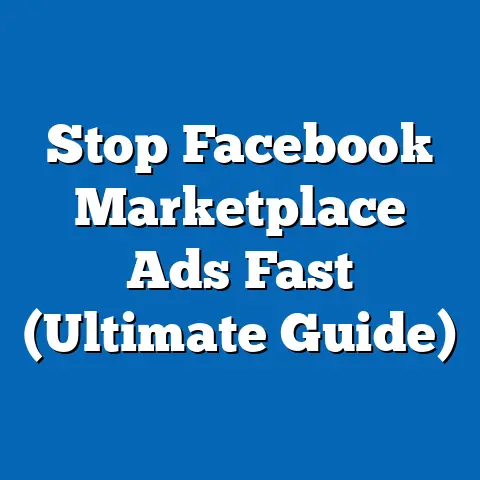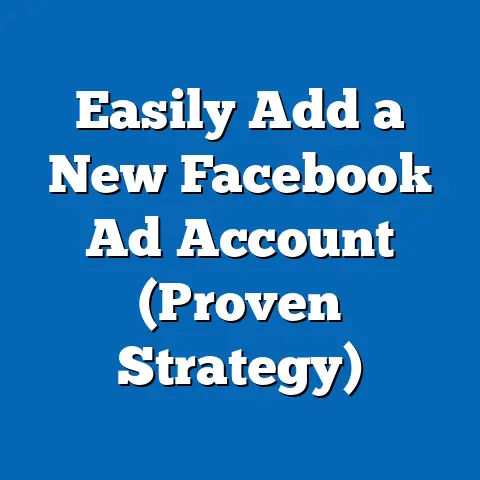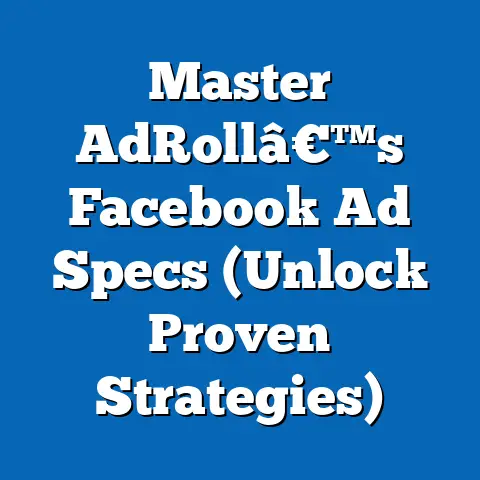Revive Facebook Ads: Unlock Conversion Secrets (Pro Tips)
I remember the early days of Facebook advertising. It felt like the Wild West, didn’t it? Simple “Like” buttons, basic demographic targeting, and a general sense of novelty meant even the most rudimentary ads could generate impressive results. We were all just figuring it out, and there was an undeniable charm to that simplicity. Now, as I look at the complex landscape of Facebook advertising, I sometimes feel a pang of nostalgia for those simpler times. But, I also know that the sophistication of today’s platform presents incredible opportunities for those willing to adapt and optimize. That’s why I’m writing this guide: to help you revive your Facebook ad strategies, unlock conversion secrets, and achieve the results you deserve.
The Current State of Facebook Advertising
Facebook has come a long way from its humble beginnings as a social network for college students. It’s now a global advertising behemoth, a place where businesses of all sizes compete for attention. Let’s take a moment to understand where we stand in this ever-evolving ecosystem.
Overview of Facebook’s Advertising Ecosystem
The numbers speak for themselves. Facebook boasts billions of active users, making it a fertile ground for reaching potential customers. According to Statista, Facebook’s advertising revenue continues to grow, demonstrating its enduring value to marketers. This growth is fueled by the platform’s diverse ad formats, which cater to various business needs and marketing goals.
Here’s a quick rundown of the most popular ad formats:
- Image Ads: The classic choice, ideal for showcasing products or services with compelling visuals.
- Video Ads: Captivating and engaging, perfect for telling stories and demonstrating product features.
- Carousel Ads: Allow users to swipe through multiple images or videos, ideal for showcasing a range of products or highlighting different aspects of a single product.
- Collection Ads: Designed for mobile shoppers, these ads combine images and videos to create an immersive shopping experience.
- Lead Ads: Streamline lead generation by allowing users to submit their information directly within the ad, reducing friction.
- Instant Experiences: Full-screen, mobile-optimized experiences that load quickly and provide an engaging way to interact with your brand.
- Stories Ads: Short, vertical videos or images that appear between users’ Stories, offering a natural and engaging way to reach your audience.
Each of these formats offers unique advantages, and the key to success lies in choosing the right format for your specific goals and audience.
Shifting Consumer Behavior
Consumer behavior on social media is constantly evolving, and it’s crucial to stay ahead of the curve. Here are a few key trends to consider:
- Mobile-First Mindset: Most Facebook users access the platform via their mobile devices. This means your ads must be optimized for mobile viewing, with clear visuals, concise copy, and fast loading times.
- Video Dominance: Video content continues to reign supreme. Users are more likely to engage with video ads than static images, so consider incorporating video into your ad strategy.
- Authenticity and Transparency: Consumers are increasingly skeptical of overly polished or salesy ads. They crave authenticity and transparency, so focus on creating genuine connections with your audience.
- Personalization is Key: Generic ads are a surefire way to get ignored. Users expect personalized experiences that cater to their specific interests and needs.
- Short Attention Spans: In today’s fast-paced world, attention spans are shorter than ever. Your ads need to grab attention quickly and deliver your message effectively.
Takeaway: To thrive in today’s Facebook advertising landscape, you need to understand the platform’s diverse ad formats and adapt to evolving consumer behavior. Focus on mobile optimization, video content, authenticity, personalization, and conciseness.
Understanding Your Audience
One of the biggest mistakes I see marketers make is failing to truly understand their audience. It’s not enough to simply target broad demographics; you need to dive deep and uncover the nuances of your ideal customer.
Defining Your Target Audience
Facebook’s targeting capabilities are incredibly powerful, allowing you to reach specific groups of people based on a wide range of factors. These include:
- Demographics: Age, gender, location, education, relationship status, and more.
- Interests: Hobbies, passions, and topics that users have expressed interest in.
- Behaviors: Past purchases, website visits, app usage, and other online activities.
- Connections: People who like your page, their friends, or users who have interacted with your app or event.
- Custom Audiences: Allows you to target existing customers by uploading their contact information or using website and app activity data.
- Lookalike Audiences: Find new customers who are similar to your existing ones based on shared characteristics and behaviors.
By combining these targeting options, you can create highly specific audiences that are more likely to engage with your ads.
Building Customer Personas
A customer persona is a semi-fictional representation of your ideal customer, based on research and data about your existing customers. Creating customer personas helps you understand their needs, motivations, and pain points, allowing you to create more relevant and effective ad campaigns.
Here’s a step-by-step guide to building customer personas:
- Gather Data: Start by gathering data about your existing customers. This can include demographic information, purchase history, website behavior, and social media activity.
- Identify Patterns: Look for patterns and commonalities in your data. What are the key characteristics that define your ideal customer?
- Create Personas: Based on your data analysis, create detailed customer personas. Give each persona a name, a photo, and a backstory. Include information about their demographics, interests, goals, challenges, and motivations.
- Validate Your Personas: Share your personas with your team and get their feedback. Do they accurately represent your target audience?
- Use Your Personas: Use your customer personas to inform your ad targeting and content creation. Tailor your ads to resonate with the specific needs and interests of each persona.
Example:
Let’s say you’re selling organic skincare products. You might create a persona called “Eco-Conscious Emily.” Emily is a 30-year-old woman who is passionate about sustainability and healthy living. She’s concerned about the ingredients in her skincare products and is willing to pay more for products that are organic and cruelty-free. She follows several eco-friendly influencers on social media and is always looking for new ways to reduce her environmental impact.
By understanding Emily’s motivations and pain points, you can create ads that speak directly to her needs. You might highlight the organic ingredients in your products, emphasize your commitment to sustainability, and showcase testimonials from other eco-conscious customers.
Takeaway: Don’t underestimate the power of audience understanding. Define your target audience using Facebook’s targeting capabilities and create detailed customer personas to guide your ad strategy. The more you know about your ideal customer, the more effective your ads will be.
Crafting Compelling Ad Content
Once you understand your audience, the next step is to create compelling ad content that grabs their attention and motivates them to take action. This involves mastering the art of storytelling, creating visually appealing ads, and crafting effective copy.
The Art of Storytelling
Storytelling is a powerful tool for connecting with your audience on an emotional level. People are more likely to remember and engage with stories than with dry facts and figures.
Here are a few tips for incorporating storytelling into your ads:
- Focus on Emotion: Tap into your audience’s emotions by telling stories that evoke feelings of joy, sadness, inspiration, or excitement.
- Create a Narrative: Develop a clear narrative with a beginning, middle, and end. This will help you keep your audience engaged and invested in your story.
- Use Visuals: Visuals are essential for bringing your stories to life. Use high-quality images or videos that capture the essence of your story.
- Keep it Concise: Remember that attention spans are short, so keep your stories concise and to the point.
- Connect to Your Brand: Make sure your stories are relevant to your brand and your target audience.
Example:
Instead of simply showcasing your product’s features, tell a story about how it has helped your customers solve a problem or achieve a goal. For example, if you’re selling a weight loss program, you might tell the story of a customer who struggled with their weight for years and finally achieved their dream body with your program.
Visual Appeal
In the crowded world of social media, visuals are crucial for capturing attention. Your ads need to stand out from the noise and grab users’ attention within seconds.
Here are a few tips for creating visually appealing ads:
- Use High-Quality Images: Always use high-resolution images that are clear, crisp, and visually appealing.
- Choose Eye-Catching Colors: Use colors that are consistent with your brand and that stand out from the Facebook newsfeed.
- Use Motion Graphics: Motion graphics can add a dynamic element to your ads and make them more engaging.
- Optimize for Mobile: Make sure your visuals are optimized for mobile viewing, with clear text and easy-to-understand graphics.
- Test Different Visuals: Experiment with different visuals to see what resonates best with your audience.
Crafting Effective Copy
Even with stunning visuals, your ad copy is essential for conveying your message and motivating users to take action.
Here are a few best practices for writing effective ad copy:
- Know Your Audience: Write your copy with your target audience in mind. Use language that resonates with them and addresses their specific needs and interests.
- Highlight Benefits: Focus on the benefits of your product or service, rather than just the features. What problem does it solve? How will it improve their lives?
- Use Strong Headlines: Your headline is the first thing users will see, so make it count. Use strong, attention-grabbing headlines that pique their interest.
- Keep it Concise: Get straight to the point and avoid unnecessary jargon or fluff.
- Include a Clear Call to Action (CTA): Tell users exactly what you want them to do, whether it’s visiting your website, signing up for a newsletter, or making a purchase.
Examples of Effective CTAs:
- “Shop Now”
- “Learn More”
- “Sign Up Today”
- “Get Started”
- “Download Now”
Takeaway: Compelling ad content is the key to driving engagement and conversions. Master the art of storytelling, create visually appealing ads, and craft effective copy that resonates with your target audience.
The Power of Retargeting
Retargeting is one of the most powerful tools in the Facebook advertising arsenal. It allows you to re-engage users who have previously interacted with your brand, increasing the likelihood of conversion.
Understanding Retargeting
Retargeting works by tracking users who have visited your website, viewed your products, or interacted with your ads. You can then show them targeted ads on Facebook, reminding them of your brand and encouraging them to take action.
Here’s why retargeting is so effective:
- Increased Brand Awareness: Retargeting helps keep your brand top-of-mind, even after users have left your website.
- Higher Conversion Rates: Users who have previously interacted with your brand are more likely to convert than new visitors.
- Personalized Messaging: You can tailor your retargeting ads to the specific actions users have taken on your website, creating a more personalized and relevant experience.
- Improved ROI: Retargeting can significantly improve your return on investment by focusing your advertising efforts on users who are already interested in your brand.
Setting Up Retargeting Campaigns
Setting up retargeting campaigns on Facebook is relatively straightforward, but it requires careful planning and execution.
Here’s a step-by-step guide:
- Install the Facebook Pixel: The Facebook Pixel is a snippet of code that you place on your website to track user activity. You can install the Pixel through Facebook Ads Manager.
- Create Custom Audiences: Use the Facebook Pixel to create custom audiences based on specific actions users have taken on your website, such as visiting specific pages, adding items to their cart, or making a purchase.
- Create Retargeting Ads: Create targeted ads that are relevant to the specific actions users have taken. For example, if a user added an item to their cart but didn’t complete the purchase, you might show them an ad reminding them of the item and offering a discount to encourage them to complete the purchase.
- Set Your Budget and Schedule: Set your budget and schedule for your retargeting campaigns, just like you would for any other Facebook ad campaign.
- Monitor and Optimize: Continuously monitor the performance of your retargeting campaigns and make adjustments as needed to improve your results.
Example:
Imagine someone visits your online store and browses a particular pair of shoes but doesn’t add them to their cart. A retargeting ad could show them that exact pair of shoes, perhaps with a special offer like free shipping, reminding them of their interest and incentivizing them to complete the purchase.
Takeaway: Retargeting is a must-have for any serious Facebook advertiser. By re-engaging users who have previously interacted with your brand, you can significantly increase your conversion rates and improve your ROI.
A/B Testing for Optimal Performance
In the ever-changing world of Facebook advertising, continuous improvement is essential. A/B testing allows you to experiment with different ad elements and make data-driven decisions to optimize your campaigns.
Importance of A/B Testing
A/B testing, also known as split testing, involves creating two or more versions of an ad and showing them to different segments of your audience. By comparing the performance of each version, you can identify which elements are most effective and make adjustments accordingly.
Here’s why A/B testing is so important:
- Data-Driven Decisions: A/B testing allows you to make data-driven decisions about your ads, rather than relying on guesswork or intuition.
- Improved Performance: By continuously testing and optimizing your ads, you can improve their performance over time.
- Increased ROI: A/B testing can help you identify the most effective ad strategies, leading to increased ROI.
- Reduced Risk: By testing different ad elements before launching a full-scale campaign, you can reduce the risk of wasting your advertising budget on ineffective ads.
What to Test
There are countless elements you can test in your Facebook ads, but here are a few of the most important:
- Headlines: Test different headlines to see which ones grab the most attention.
- Images: Test different images to see which ones resonate best with your audience.
- Copy: Test different ad copy to see which messages are most effective.
- CTAs: Test different calls to action to see which ones drive the most conversions.
- Targeting: Test different targeting options to see which audiences are most responsive.
- Ad Placement: Test different ad placements to see which ones deliver the best results.
- Landing Pages: Test different landing pages to see which ones convert the most visitors.
Example:
You could test two different headlines for the same ad, one that focuses on the benefits of your product and another that focuses on the urgency of making a purchase. By comparing the performance of each headline, you can determine which one is more effective at driving clicks and conversions.
Takeaway: A/B testing is an essential part of any successful Facebook advertising strategy. By continuously testing and optimizing your ads, you can improve their performance, increase your ROI, and stay ahead of the competition.
Leveraging Facebook’s Advanced Features
Facebook offers a range of advanced features that can help you take your advertising to the next level. These include the Facebook Pixel and Lookalike Audiences.
Utilizing Facebook Pixel
I mentioned the Facebook Pixel earlier, but it’s worth diving deeper into just how powerful this tool is. The Facebook Pixel is a small piece of code that you place on your website to track user activity. It allows you to track conversions, optimize your ads, and build targeted audiences.
Here are some of the key benefits of using the Facebook Pixel:
- Conversion Tracking: The Pixel allows you to track conversions on your website, such as purchases, sign-ups, and lead submissions. This data helps you understand which ads are driving the most valuable actions.
- Ad Optimization: By tracking conversions, the Pixel allows Facebook to optimize your ads for better performance. Facebook can use this data to show your ads to users who are most likely to convert.
- Audience Building: The Pixel allows you to build custom audiences based on specific actions users have taken on your website. This allows you to create highly targeted retargeting campaigns.
Setting up the Facebook Pixel:
- Create a Pixel: In Facebook Ads Manager, navigate to the “Pixels” section and create a new Pixel.
- Install the Pixel Code: Copy the Pixel code and paste it into the header of your website.
- Set Up Event Tracking: Configure event tracking to track specific actions users take on your website, such as adding items to their cart, initiating checkout, or completing a purchase.
Implementing Lookalike Audiences
Lookalike Audiences are one of my favorite Facebook advertising tools. They allow you to reach new customers who are similar to your existing ones, based on shared characteristics and behaviors.
Here’s how Lookalike Audiences work:
- Create a Source Audience: Start by creating a source audience based on your existing customers, website visitors, or app users.
- Create a Lookalike Audience: In Facebook Ads Manager, create a Lookalike Audience based on your source audience.
- Choose a Similarity Percentage: Choose a similarity percentage, which determines how closely the Lookalike Audience will resemble your source audience. A lower percentage will result in a larger audience with less similarity, while a higher percentage will result in a smaller audience with more similarity.
- Target Your Lookalike Audience: Target your Lookalike Audience with your Facebook ads, just like you would with any other audience.
Example:
If you have a customer list of 1,000 of your best customers, you can upload that list to Facebook and create a Lookalike Audience. Facebook will then analyze the characteristics and behaviors of those customers and find new users who are similar to them.
Takeaway: Facebook’s advanced features, such as the Facebook Pixel and Lookalike Audiences, can help you take your advertising to the next level. By leveraging these tools, you can track conversions, optimize your ads, and reach new customers who are more likely to convert.
Measuring Success and KPIs
Measuring the success of your Facebook ad campaigns is crucial for understanding what’s working and what’s not. This involves defining key performance indicators (KPIs) and analyzing the data provided by Facebook Ads Manager.
Defining Key Performance Indicators (KPIs)
KPIs are specific, measurable, achievable, relevant, and time-bound metrics that you use to track the performance of your ad campaigns.
Here are some essential KPIs for measuring Facebook ad effectiveness:
- Click-Through Rate (CTR): The percentage of users who click on your ad after seeing it. A high CTR indicates that your ad is relevant and engaging.
- Cost Per Click (CPC): The amount you pay each time someone clicks on your ad. A low CPC indicates that your ad is efficient and cost-effective.
- Conversion Rate: The percentage of users who take a desired action after clicking on your ad, such as making a purchase, signing up for a newsletter, or submitting a lead form. A high conversion rate indicates that your ad is effective at driving conversions.
- Cost Per Acquisition (CPA): The amount you pay to acquire a new customer. A low CPA indicates that your ad is efficient at driving customer acquisition.
- Return on Ad Spend (ROAS): The amount of revenue you generate for every dollar you spend on advertising. A high ROAS indicates that your ad is profitable.
- Impressions: The number of times your ad is displayed. A high number of impressions indicates that your ad is reaching a large audience.
- Reach: The number of unique users who see your ad. A high reach indicates that your ad is reaching a broad audience.
- Frequency: The average number of times each user sees your ad. A high frequency can lead to ad fatigue, while a low frequency may not be enough to make an impact.
Analyzing and Interpreting Data
Facebook Ads Manager provides a wealth of data about your ad campaigns. It’s important to analyze this data regularly to gather insights and make informed decisions for future campaigns.
Here are some tips for analyzing Facebook Ads Manager data:
- Focus on the KPIs that matter most to your business goals. Don’t get bogged down in irrelevant metrics.
- Look for trends and patterns in your data. Are certain ads performing better than others? Are certain audiences more responsive?
- Compare your results to industry benchmarks. Are you performing above or below average?
- Use A/B testing to identify the most effective ad elements.
- Make adjustments to your campaigns based on your data analysis.
Takeaway: Measuring success is essential for optimizing your Facebook ad campaigns. Define your KPIs, analyze your data, and make adjustments as needed to improve your results.
Conclusion: Embracing Change for Future Success
As I reflect on the journey of Facebook advertising, from its humble beginnings to its current complexity, one thing is clear: adaptability is key. The platform is constantly evolving, with new features, algorithms, and best practices emerging all the time. To thrive in this dynamic environment, you need to embrace change, stay updated with the latest trends, and continuously optimize your strategies.
Remember those early days of Facebook ads? The simplicity, the novelty, the sense of discovery? While we can’t go back to that era, we can learn from it. We can recapture that spirit of experimentation and innovation, and apply it to the sophisticated tools and techniques available today.
By understanding your audience, crafting compelling content, leveraging retargeting, A/B testing for optimization, utilizing Facebook’s advanced features, and measuring your success, you can revive your Facebook ad strategies and unlock the conversion secrets you need to achieve your business goals.
So, embrace the challenge, stay curious, and never stop learning. The world of Facebook advertising is constantly evolving, and the opportunities for success are endless.

